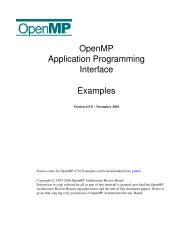D2 3 Computing e-Infrastructure cost calculations and business _models_vam1-final
D2 3 Computing e-Infrastructure cost calculations and business _models_vam1-final
D2 3 Computing e-Infrastructure cost calculations and business _models_vam1-final
Create successful ePaper yourself
Turn your PDF publications into a flip-book with our unique Google optimized e-Paper software.
e-‐FISCAL: www.efiscal.eu <br />
EC Contract Number: 283449 <br />
a server cluster of equivalent capability. Cohen <strong>and</strong> Karagiannis (2011) made a first attempt to approximate the <br />
<strong>cost</strong> of EGI. Their study, conducted within the e-‐IRGSP2 project, attempted an approximation of the <strong>cost</strong> of the <br />
EGI pan–European grid infrastructure for 2009 by extrapolating the <strong>cost</strong> of a few (seven) selected NGIs as example <br />
cases. Moreover, this study presents the <strong>cost</strong> per CPU core hour under alternative CPU utilisation rates <strong>and</strong> <br />
performs as a <strong>final</strong> step, rough comparisons between these <strong>cost</strong>s <strong>and</strong> Amazon EC2 prices. <br />
Risch <strong>and</strong> Altmann (2008) analyse the question whether using the Cloud is financially advantageous compared to <br />
the Amazon.com EC2 service. To perform this analysis they calculate the <strong>cost</strong>s of computing resources in different <br />
usage scenarios, reflecting cases where Cloud resources <strong>and</strong> in-‐house resources are used. The comparison of the <br />
<strong>cost</strong>s reveals that while the Cloud is cheaper in the short term, it is not a good investment in the long term <strong>and</strong>, <br />
thus, the existence of a Cloud economy will not lead to an end of ownership but rather to a reduction of in-‐house <br />
resources <strong>and</strong> more efficient resource usage. <br />
The review of relevant literature briefly discussed above enabled us to take a more informed decision on two <br />
issues: a) the identification of the distinctive <strong>cost</strong> objects for which <strong>cost</strong> data should be gathered in order to run <br />
our <strong>cost</strong>ing exercise <strong>and</strong> b) the <strong>cost</strong>ing methodology that would best fit to our requirements (we discuss this issue <br />
in more detail in the methodology section). Moreover, we had identified the <strong>cost</strong> per core hour in several settings <br />
to compare with the results of our <strong>cost</strong> analysis. <br />
2.3 In-house computing infrastructures <strong>and</strong> commercial cloud solutions<br />
As part of the state of the art analysis, a number of comparison studies were evaluated to better underst<strong>and</strong> the <br />
pros <strong>and</strong> cons of the in-‐house computing infrastructures vs. commercial cloud offerings. In terms of scope, the in-house<br />
computing infrastructures may refer to the European initiatives e.g. EGI, PRACE <strong>and</strong> other national or <br />
regional computing facilities. On the other h<strong>and</strong>, there are many commercial cloud providers e.g. Amazon EC2, <br />
Rackspace, Salesforce.com, etc. In the following few paragraphs, we summarise the analysis of various <br />
comparison studies that were included in the state of the art review. <br />
One of the most common arguments made for the adoption of cloud computing is the potential <strong>cost</strong> saving <br />
compared to deploying <strong>and</strong> operating in-‐house infrastructure. This argument is based on several parameters. <br />
Commercial clouds consolidate dem<strong>and</strong> across a large customer base, resulting economies of scale that small <br />
departmental clusters cannot achieve such as lower number of FTEs per core, stronger purchasing power when <br />
negotiating with the vendor, <strong>and</strong> better power efficiency since large systems can justify investing more in the <br />
design of the cooling infrastructure. Low upfront <strong>cost</strong>s <strong>and</strong> pay-‐as-‐you go <strong>models</strong> are also considered advantages <br />
of clouds. Clouds allow users to avoid both time-‐investments <strong>and</strong> <strong>cost</strong>s associated with building out facilities, <br />
procuring hardware <strong>and</strong> services, <strong>and</strong> deploying systems. Users are able to get access to on-‐dem<strong>and</strong> resources <br />
<strong>and</strong> only pay for the services they use. Ultimately, whether a cloud offering is less <strong>cost</strong>ly than owning <strong>and</strong> <br />
operating in-‐house resources is very dependent on the details of the workload, including characteristics such as <br />
scaling requirements, overall utilization, <strong>and</strong> time criticality of the workload (Magellan, 2011). <br />
Lin <strong>and</strong> Chen (2012) investigated how cloud computing is understood by IT professionals <strong>and</strong> the concerns that IT <br />
professionals have in regard to the adoption of cloud services. The findings of this study conducted through <br />
interviews in Taiwan suggest that while the benefits of cloud computing such as its computational power <strong>and</strong> <br />
ability to help companies save <strong>cost</strong>s are often mentioned in the literature, the primary concerns that IT managers <br />
e-‐FISCAL : Financial Study for Sustainable <strong>Computing</strong> e-‐<strong>Infrastructure</strong>s <br />
Deliverable <strong>D2</strong>.3 – <strong>Computing</strong> e-‐<strong>Infrastructure</strong>s <strong>cost</strong> estimation <strong>and</strong> analysis – Pricing <strong>and</strong> <br />
Business <strong>models</strong> <br />
25




